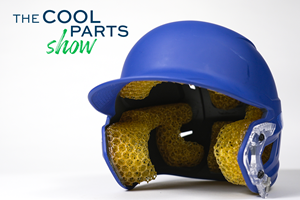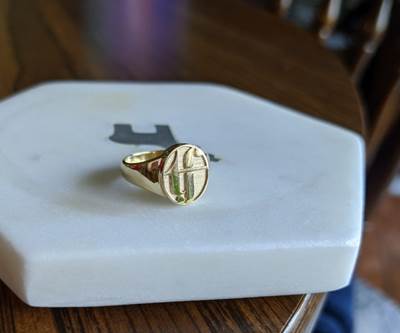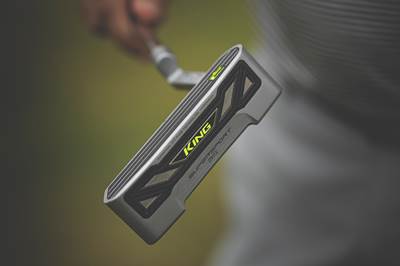3D Printed Putter Tailored to the Golfer: The Cool Parts Show #49
An engineering student in South Africa used metal and polymer 3D printing in tandem to create a putter customized to the individual golfer’s swing.
Share
Golf clubs are almost always purchased off-the-shelf, or else expert golfers obtaining custom clubs face limited options for customizability and long waits to obtain them. Competitive golfer and engineering student Wian van Aswegen of Nelson Mandela University in Port Elizabeth, South Africa, saw additive manufacturing as a way to not only expand the range of possibilities for customizing clubs, but also speed and simplify manufacturing them. His tailor-made putter, developed with AM service provider Rapid3D, uses metal AM for the angles and detail of the club head and hosel, combined with polymer AM pieces to obtain the desired overall mass and mass distribution. Van Aswegen and his advisor Clive Hands talk about the customizable putter in this episode of The Cool Parts Show. | This episode of The Cool Parts Show brought to you by Carpenter Additive
The Cool Parts Show is a video series from Additive Manufacturing Media that explores the what, how and why of unusual 3D printed parts. Watch more here.
Have a cool part to share? Email us.
Related Resources
- Nelson Mandela University Advanced Engineering Design Program
- Rapid3D
- Another putter made through 3D printing
- Other customization examples: eyeglasses, footwear, jewelry, mouth guard
Transcript
Peter Zelinski
I'm Pete.
Stephanie Hendrixson
I'm Stephanie.
Peter Zelinski
Welcome to The Cool Parts Show.
Stephanie Hendrixson
This is our show all about cool, unique, interesting 3D printed parts. And today we're talking about this putter.
Peter Zelinski
We're talking about a 3D printed putter, 3D printing for golf.
Stephanie Hendrixson
And this club has a lot of things going on for it. We're going to talk about both metal and polymer 3D printing. We're going to talk about mass customization. And I think this is probably our furthest traveled cool part to date.
Peter Zelinski
This putter was developed at Nelson Mandela University in South Africa by an engineering student and his professor. They are viewers of the show, fans of the show. They catch it regularly and they reached out to us to tell us about the work they're doing in 3D printing to create this putter. And we got interested.
Stephanie Hendrixson
Yeah. So the student engineer that we're talking about, his name is Wian van Aswegen and he is a very accomplished golfer. He started playing golf as a kid. By the time he was eight years old, he was playing in his provincial team, which is sort of like state level here in the US. At one point he was ranked in the top ten golfers in his region. So a very, very elite golfer and he got to know a lot of other elite golfers. And something that he noticed was that when you get to play golf at a certain level, you start to want different things out of your equipment. You start to want more specific things in terms of loft angle and balance and the way that the club feels. And there just aren't that many good options for getting a customized club that's made just for you.
Peter Zelinski
You and I, we don't know golf. We understand additive manufacturing a lot better than golf, but Wian understands both.
Stephanie Hendrixson
Yeah, so Wian has all this experience with golf. He's also studying engineering and at Nelson Mandela University, he's involved in something called the Advanced Engineering Design Group, which is where he sort of had access to additive manufacturing technology and where this idea kind of took shape. So let's meet him.
Wian van Aswegen
It basically just came about by just chatting about my background when I joined the Advanced Engineering and Design group here at Nelson Mandela University. And then basically just snowballed the idea of why don't we just create our own golf or golf club actually. Looking at the different ideas of like how we can do this and what is available to us, we came up with the idea of additive manufacturing. To try and incorporate that. And also if you if you think about the manufacturers nowadays, they mainly cater for the masses. So basically what they do is they create the same design over and over and over, thousands, maybe even millions of times. The high level golfers don't really get that putter that is designed specifically for them to optimize their performance.
Peter Zelinski
He's part of this special group. Like you said, he had help. So here is his adviser who is a lecturer with that special program. You mentioned the AE Design Group.
Clive Hands
I run the group called the Advanced Engineering Design Group, where we have students that are passionate about design and specifically new technologies. They come here with ideas or we send ideas out to a general student population. So it's very much not part of the curriculum. And what it does is it enables us to expose them to things like design for additive manufacturing, composites, skills, design methodologies which they wouldn't necessarily meet or be exposed to as part of your standard engineering curriculum. My thing is very much to let them have free rein, as not constrain ideas, but rather to really have the guys broaden their horizons and get some creative abilities in there, which can sometimes be stymied in a standard engineering environment, which is typically subtractive, for example.
Stephanie Hendrixson
So this is the context where this putter was developed. This Advanced Engineering Design Group, it's sort of this special group at the university. It's not something that students are necessarily getting credit for participating in, but it is this place where they can come with their ideas. They can play around, they can experiment.
Peter Zelinski
Yeah, but it wasn't just a playful idea. This is a real solution to a real problem with real commercial potential. Wian saw that golfers at a certain level routinely wanted to take their game farther by getting just the right equipment, equipment tailored to their particular swing. And what he was learning about advanced manufacturing technology showed him that he could see a way to do that tailoring better and faster.
Stephanie Hendrixson
Yeah, because if you think about those conventional clubs that you buy off the shelf, the head is probably going to start as a casting or forging. So that means there's tooling involved, there's lead time before you even get to that piece of metal. And then once you have it, there's going to be machining, there's going to be finishing. There might be like painting and other aesthetic touches before it gets assembled with the handle and becomes a golf club.
Peter Zelinski
Okay. So there's a lot going on here in terms of the potential geometric variation from club to club. We can't see it in just like one specimen of the club. But any given individual golfer who wants a putter attuned to their swing, they basically want a putter that's attuned to like essentially the way their body works when they're playing golf. And that leads to all kinds of different possibilities in terms of the geometric variation that might be needed.
Wian van Aswegen
With different putters there are quite a lot of specifications that the person could come to us. Those are mainly stuff like your loft, your light angle, your balance, your mass that you would acquire, your groove pattern. All of this makes a difference, not just in performance but also aesthetically. And yeah, in terms of balances it refers to the weight distribution of the putter. So there are three different, three main different types of balances. The first balance is face balance. So if you hold the putter like this, the putter face would be pointing directly upwards. And then the second balance would be if you hold it like this, then the putter would hang at roughly a 30 degree angle that is called quarter balance. And then the third one is the putter is hanging completely down and that is called toe balance. And so this would roughly be like 70 degrees or so on. So those are the different balances and the balance refers to the golfer's stroke arc. To try and go straight back, straight through the golf ball is kind of difficult sometimes for some people. So the balance is trying to counteract that movement that you would have in your stroke to try and get it as consistent as possible.
Peter Zelinski
Wian is describing all the different ways the geometry could vary and it gets right to what you were saying about casting that you wouldn't want to have you couldn't have all of the tooling that would be needed to handle all those different variations, different molds or different patterns. Like it would just be impossible to tailor a club that way. But 3D printing provides a way that makes it natural to tailor the club from individual to individual and make every club different. And this is an interesting part even for The Cool Parts Show, because we have done 3D printed metal cool parts, we have done 3D printed polymer cool parts. This is metal and polymer working together.
Stephanie Hendrixson
Yeah. So let's get to the 3D printing. You want to talk about the metal part first? How was that made?
Peter Zelinski
The 3D printed component of this, the clubhead and the hozzle. This was made through laser powder bed fusion on an M290 machine from EOS. It was made by Rapid 3D, which is an additive manufacturing service provider in South Africa. Material is 314 stainless steel. Printing this took about 24 hours and it was just about complete at that point because the process was engineered and the part was designed in part to minimize the need for post-processing.
Stephanie Hendrixson
Yeah. And that's sort of interesting for metal 3D printing. A lot of times we see a lot of machining happening after printing, but they designed this part to have no overhangs and there really wasn't very much that needed to happen other than cutting the part off the build plate at the end.
Peter Zelinski
Okay. So, so that gets us to the polymer components like let's look at those. The polymer components are for weight control. In the case of this product, mass customization includes customization of the mass. These components, what's hidden inside them is varying lattice structures. So these polymer weights achieve exactly the mass that's needed for this individuals club along with the proper distribution of that mass.
Stephanie Hendrixson
So these polymer components were made with a different process. This is fused filament fabrication, FFF, an extrusion style 3D printing. They were 3D printed on a machine from Markforged at the Advanced Engineering Design Group, and they're made out of Onyx, which is a carbon fiber reinforced nylon material. And so these parts are weights, as you said, they're there to distribute the weight across the club. But what I think is really interesting about them is that the way they're attached is just these two screws on the bottom here. And so you can imagine a scenario where you might use this putter for a while and decide something about it isn't quite working, or there's something about my swing that's changing and I want to get new weights. And you could very easily have new weights printed and just swap them out. So this putter is very adaptable, very customizable at the outset, but it can also change and adapt with you as your gameplay changes.
Clive Hands
Your more serious golfer up there. They tend to be forced to buy things off the shelf, which tend to be very standardized, some very nice putters, but they tend to be standardized. So they don't have their own signature in respect. And you'll see even here with the new updated putter, not the one that you've got, we've actually printed in Wian's insignia onto the actual thing. So it means we can actually, we can get a lot of customization on a putter, which can really make it unique to the actual individual user.
Stephanie Hendrixson
So what Clive just described and what Wian is thinking about, this gets beyond the customization options that are available to golfers today, just in terms of the weight distribution, the angles, the way that the putter feels. And there's also that aesthetic option as well to add designs, to add monograms and things to your club and make it really, really personalized.
Peter Zelinski
Yeah. So next step Wian wants to commercialize this idea. He imagines an engineering career in the sporting goods industry, in the golf industry. But in order for this tailor made putter idea to advance, for it to be able to be used competitively, he has to ensure that every possible variation meets the requirements of the Royal and Ancient Rules of Golf, which is the governing body overseeing these things. So he has a ways to go, but stay tuned.
Stephanie Hendrixson
All right. I think we got this.
Peter Zelinski
I think we do, too.
Stephanie Hendrixson
But, you know, we always do this part sitting right here. I think we should try something different. This is a golf putter with a 3D printed head. It combines metal and polymer 3D prints for a club that can be fully customized to the user.
Peter Zelinski
The putter is made through additive manufacturing and can be tailored all kinds of ways, the geometry, the weight, the balance, which refers to the angle of this club face.
Stephanie Hendrixson
This club was the idea of Wian van Aswegen, a golfer and student engineer at Nelson Mandela University. He had help from Clive Hands, who was a lecturer there, and also leads the Advanced Engineering Design Group. And they got assistance from Rapid 3D with the metal 3D printing on this club.
Peter Zelinski
The metal part is made of stainless steel made through laser powder bed fusion and 3D printed in about a day.
Stephanie Hendrixson
The polymer portions of this clubhead were 3D printed using fused filament fabrication out of a carbon fiber reinforced polymer. They are the weights on the clubhead and they can also be customized with the golfer's chosen design.
Peter Zelinski
To commercialize this putter Wian needs to assure that it conforms to the rules of golf. But once he can do that, competitive golfers can get putters customized to their bodies, balance and swings, and get them in a matter of days.
Stephanie Hendrixson
That's it for this round of mini golf and this episode of The Cool Parts Show.
Peter Zelinski
If you have a cool part you'd like to tell us about, maybe it'll be an episode of the show. Email us. CoolParts@AdditiveManufacturing.media
Stephanie Hendrixson
If you enjoyed this episode, if you like the show, leave us a like leave us a comment and tell us what you enjoyed and make sure to subscribe so you don't miss any of our new episodes. Thanks for watching.
Related Content
This Drone Bird with 3D Printed Parts Mimics a Peregrine Falcon: The Cool Parts Show #66
The Drone Bird Company has developed aircraft that mimic birds of prey to scare off problem birds. The drones feature 3D printed fuselages made by Parts on Demand from ALM materials.
Read More3D Printed Spine Implants Made From PEEK Now in Production
Medical device manufacturer Curiteva is producing two families of spinal implants using a proprietary process for 3D printing porous polyether ether ketone (PEEK).
Read More3D Printed Lattices Replace Foam for Customized Helmet Padding: The Cool Parts Show #62
“Digital materials” resulting from engineered flexible polymer structures made through additive manufacturing are tunable to the application and can be tailored to the head of the wearer.
Read More3D Printing with Plastic Pellets – What You Need to Know
A few 3D printers today are capable of working directly with resin pellets for feedstock. That brings extreme flexibility in material options, but also requires greater knowledge of how to best process any given resin. Here’s how FGF machine maker JuggerBot 3D addresses both the printing technology and the process know-how.
Read MoreRead Next
The Future of Jewelry Manufacturing Is Custom, On Demand and Perfectly Sized
The Melvin sisters launched their startup, The Future of Jewelry, when they couldn’t find matching signet rings. Now, customers can design exactly the ring they want, to be produced affordably through 3D printing and/or lost wax casting.
Read MoreMore Than Meets the Eye to Cobra’s 3D Printed Putter
Cobra Golf drew attention in November 2020 with the launch of a limited-edition putter with metal 3D printed head. What this club says about product development, reshoring manufacturing and the future of consumer goods.
Read More3D Printed Custom Glasses: The Cool Parts Show #8
Fitz Frames has reimagined glasses, from the frames to the ordering process. See how the company manufactures glasses customized to every face in this episode of The Cool Parts Show.
Read More















